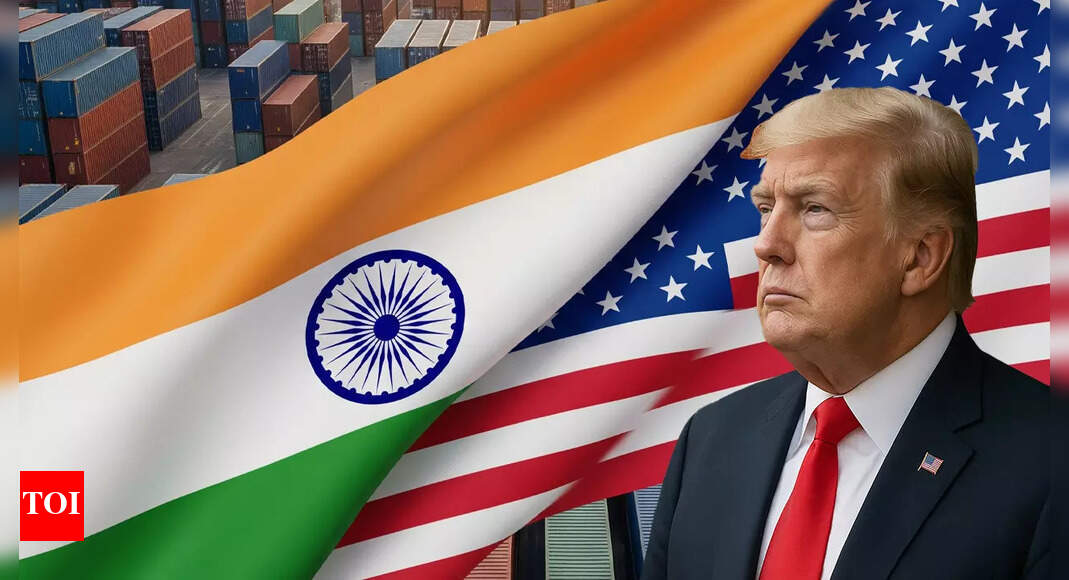
US President Donald Trump seems to be looking to make ‘an example’ out of India in his trade and tariff war, says Global Trade Research Initiative’s (GTRI). Trump has imposed a 25% tariff on India which will come into effect from August 7, 2025. Trump has also taken jibes at India, calling it a ‘dead economy’, and also expressing displeasure at BRICS group, of which India is a part.GTRI founder Ajay Srivastava has said that the ‘blanket tariff’ on India is one of the toughest actions on trade that the US has taken against trading partners in recent years.“Countries like China have retained exemptions on critical goods like pharmaceuticals, semiconductors, and energy. But India has been singled out for harsher treatment, with no product-level exemptions whatsoever. The message is clear – agree to US geopolitical views, sign a deal or suffer blanket tariffs – and India is being made the example for others, ” he said according to a PTI report.
US Tariffs on India: Impact Decoded
America’s 25% tariff on all goods originating from India is expected to significantly impact the nation’s exports to America, said GTRI. Importantly, the executive order passed by Trump on Friday includes sectors previously exempt from US import duties, including pharmaceuticals and electronics.Also Read | Donald Trump’s 25% tariff, ‘dead economy’ jibe: India sends clear message to the US in 5 points – what Piyush Goyal saidTrump’s executive order, ‘Further Modifying The Reciprocal Tariff Rates’, specifies tariff rates for approximately 70 nations.“This blanket tariff, approved by President Trump, is one of the toughest trade actions the US has taken against a key trading partner in recent years,” Srivastava said.“What sets this action apart is that, unlike many other trading partners, India has been denied all product-level exemptions, even for products and sectors, the US exempted goods from other countries,” he added.The exempted categories from tariffs include completed pharmaceutical products, APIs and essential drug components, along with energy-related items including crude oil, processed fuels, natural gas, coal and electricity. Additionally, vital minerals and numerous electronic items such as computers, tablets, mobile phones, SSDs, display panels and integrated circuits were also excluded.However, these exemptions are not applicable for India, which faces a uniform 25% ad valorem duty on all products, without any sector-specific or product-based exceptions.Also Read | Donald Trump’s 25% tariff to hit India’s exports! Which sectors are at maximum risk? Top 5 points to knowImportantly, the executive order indicates scope for tariff reductions following bilateral agreements with the United States.According to Srivastava, this directive extends beyond a simple tariff implementation and serves as a strategic negotiating tool.Indian exports will incur a 25%tariff from August 7, whilst goods in transit can maintain previous tariff rates of 10 per cent on most items (excluding steel and aluminium with 50 per cent tariffs and tariff-free items like smartphones) until October 5, 2025, according to the think tank.“The selective tariff exemptions, excluding India, will significantly impact India’s exports to the US, particularly in petroleum products ($4.1 billion in FY2025), smartphones ($10.9 billion), and Pharmaceuticals ($9.8 billion). Additional sectors including engineering goods, electronics, and textiles will also experience adverse effects from these tariffs,” he said.Additionally, he indicated that preliminary estimates suggest India’s goods exports could decrease by 30% from $86.5 billion in FY 2025 to $60.6 billion in FY 2026.Also Read | ‘India has not been a great global actor’: Donald Trump administration fires fresh salvo after 25% tariff; says Russia oil ‘most certainly a point of irritation’
Trump Tariffs: Which Sectors Will Be Hit?
The sectors most impacted will be petroleum products, pharmaceuticals and electronics, each characterised by substantial import components and minimal domestic value addition, GTRI said.The United States has implemented additional import duties from several nations, varying between 10% and 41% which are supplementary to the existing most favoured nation tariffs.According to GTRI, this implementation means that imports from affected nations will be subject to both standard US duties and supplementary reciprocal tariffs, substantially increasing overall duty rates. Nations facing elevated tariffs (25-30 per cent) include India, Brunei, Kazakhstan, Moldova, and Tunisia.India’s export competitors, including Bangladesh, Sri Lanka, Taiwan, and Vietnam, are subject to a 20% duty rate.





